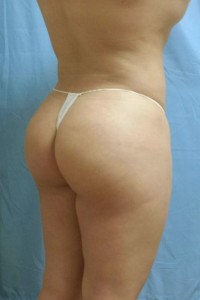

Surgeons vary in their aftercare protocols following buttock augmentation surgery. Therefore, It is best to follow your surgeon’s advice following surgery. Generally speaking, recovery from BBL varies from one patient to another based on factors related to the patient, the surgery itself and surgeon’s expertise.
In my opinion, it takes 6-8 weeks for the injected fat to “set-in” and be part of your body. From that point onward, changes to your body in terms of weight loss or gain , can affect that area accordingly.
Immediately following surgery, I use a “custom-cut” padding in the lower back, just above the buttocks, to ease off the pressure on that area and protect the injected fat. This is worn under their compression garment.
I also recommend that my patients use a very soft pillow, behind their upper thighs, while sleeping on their back for the same purpose.
Although I allow my patients to sleep on their back from day one, I ask them to attempt sleeping on their sides whenever they can. I found it hard to advice them to sleep on their tummy for prolonged periods. There is no proven method that works 100 % with zero pressure on that area. Some patients bring in commercial standard garments even pictures for “BBL beds”or mattresses. I find these impractical and not necessary. The assumed compression that these may provide can create undue pressure. Besides, no one size, fits all. However, I do recommend using a commercial personal massager to aid the reduction of the superficial bruising and swelling at the donor sites where liposuction was performed.
Wearing the garment postoperatively is mandatory and this should be worn for at least 6 weeks following surgery. Mobility is also encouraged from day one and patients are advised to advance their diet and activity to normal, as they tolerate.
Patients are seen in the office, the first postoperative day and at one week following their surgery. Then they are put on a follow-up protocol that is individualized per patient depending on the amplitude of their surgery and as to whether it was combined with other procedures.
Patients can drive their car in a week following surgery and may be able to drive for an hour plus distance, in 2 weeks. From 2 -4 weeks onward, activities can be advanced from using the elliptical and treadmill to walking and swimming . At 4 weeks, these are further advanced to other sport exercises such as jogging, and running. From 3 months onward, activities are unrestricted.










